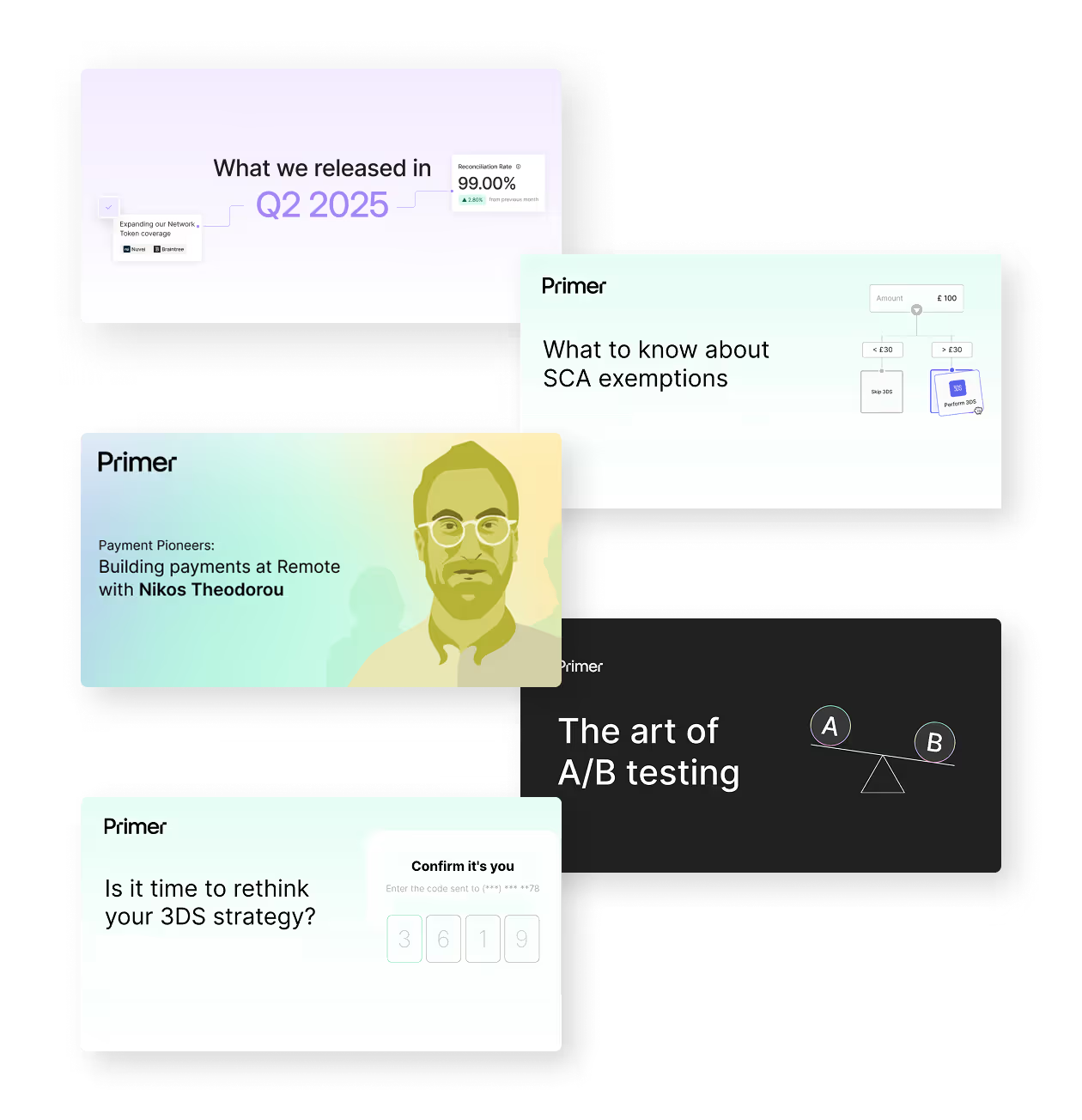The size of payment teams can vary significantly across companies, even within the same industry and business size.
One company might manage its payment operations with just a few staff members, while another might employ a team of over 50 professionals.
Then there are those companies that still operate with nobody dedicated to payments.
Lucas Quinio, Head of Payments at Conforarma, explains:
“Overall, payments is still a very new role for most businesses. I speak with many people at events, and when I tell them what I do, they’re often shocked because they didn’t realize payments is a dedicated role or that their own companies might need it too.
“On the other hand, some people are surprised that I’m the only one doing this job at Conforama. Everyone is looking for the right setup.”
This article will run you through a few key roles to consider adding to your payment team and offer up a solution that can greatly free up your in-house resources.
Primer is a unified payment infrastructure platform that simplifies all of your payment systems through a single API integration. Book a call to find out how we can help your team.
Key roles in a payments team
The structure of payment teams today is influenced by several factors, including a company’s organizational setup, technology stack, and functional maturity.
However, as payment teams evolve, specific roles are becoming essential.
Let’s explore these key roles and their responsibilities:
Head of Payments: Leads the team and oversees the strategic direction and operational efficiency of the payment systems within an organization. They ensure compliance with regulatory requirements, drive innovation, and manage relationships with financial institutions, payment processors, and other key stakeholders.
Payment Operations Manager: Oversees the daily processing of transactions, ensuring accuracy and efficiency. They handle exception management reconciliations and coordinate with other departments to resolve payment-related issues and improve operational workflows. Depending on the company's size, these individuals may also have regional remits depending on the company's size.
Fraud & Risk Manager: Will monitor and analyze transactions to detect and prevent fraudulent activities. They develop and implement risk management strategies to minimize financial losses and ensure the security of the payment systems.
Payment Product Manager: Oversees the development, launch, and lifecycle management of payment products and services. They work closely with cross-functional teams to ensure products meet market needs, regulatory requirements and drive business growth.
Payment Engineering Manager: Leads the engineering team responsible for developing and maintaining payment processing systems. They ensure payment solutions' reliability, security, and scalability while coordinating with other departments to integrate new technologies and features.
Payment Partnerships Manager: Develops and manages strategic relationships with payment processors, financial institutions, and other partners. They negotiate agreements, collaborate on joint initiatives, and ensure that partnerships align with the company’s business goals and enhance its payment capabilities.
Payments Data Analyst: Analyzes transaction data to uncover trends, patterns, and insights that inform business decisions. They generate reports, identify opportunities for optimization, and support risk management and fraud detection efforts through data-driven analysis.
As the role of payments within businesses continues to evolve, the roles within payment teams are becoming increasingly specialized and crucial to success.
Companies that recognize the strategic importance of payments are better positioned to enhance customer experiences, ensure operational efficiency, and drive growth. While some organizations are still in the early stages of building dedicated payment teams, the trend is shifting toward a more structured approach.
How Primer can free up your team's resources

Primer is a unified payments infrastructure that simplifies online payment operations through a single API integration. We eliminate complexity by providing a flexible, no-code framework that allows businesses to connect PSPs, automate payment routing, and optimize payment performance—without requiring ongoing engineering effort.
With Primer, your payments team can focus on strategy, growth, and user experience instead of managing fragmented integrations and dealing with operational bottlenecks.
Here are a few ways Primer can help your team save time:
Integrate with global and local payment service providers in just a few clicks
Manually integrating with a single PSP can take months of engineering resources. With Primer, you only need to integrate once to access a wide range of local and global processors.
Adding a new PSP takes just a few clicks, and there’s no coding required. Once you’ve signed a contract with a PSP, all you need to do is:
- Open the Primer dashboard
- Click on the PSP
- Enter your merchant ID
- Hit the connect button
- Choose the alternative payment methods you want to offer
- Add them to your checkout with Universal Checkout

Add new payment methods and manage the checkout experience with no code
Adding additional payment methods is just as simple. You can integrate new payment methods in seconds, including digital wallets like Apple Pay and Google Pay, as well as Buy Now Pay Later options like AfterPay.
Once you’ve added the payment methods you want, you can manage what you show to your customers using Universal Checkout.
Choose between Drop-in Universal Checkout or Headless Checkout:
- Drop-in Universal Checkout lets you get up and running with a fully functional, in-context checkout interface in just a few lines of code. Your team can enable or disable payment methods instantly without engineering effort.

- Headless Checkout offers complete customization, allowing you to build a fully tailored checkout experience with Primer’s powerful SDKs and APIs. This is ideal for businesses running A/B tests or optimizing conversion flows, as changes can be deployed instantly.
Find out more: Alternative payment methods: offer customers more ways to pay
Simplify payment routing with Workflows
Setting up custom payment flows and optimizing payment routes manually is complex and resource-intensive without Primer. Even the simplest routing requires specialized engineering expertise.
With Primer, you can use our Workflows tool to build and automate payment flows without writing a single line of code.
Workflows allow you to customize payment flows based on multiple attributes. For example, you can configure a workflow to trigger based on:
- A specific customer ID
- A particular acquirer (e.g., PayPal)
- The region where the transaction is taking place
- And much more.

For example, you could use Workflows to:
- A/B test different payment routes to assess performance and optimize authorization rates.
- Reduce transaction fees by dynamically routing payments to the most cost-effective provider. If one processor offers lower fees for Visa transactions, you can configure Workflows to route Visa payments there while directing other card types elsewhere.
With Primer, you gain full control over your payment operations without requiring additional engineering resources.
Learn more: Payment routing: Everything you need to know
Analyze and report on PSP performance with real-time insights
Building an effective payment strategy requires a deep understanding of your payment processors' performance. But gathering this data manually is time-consuming and inefficient—you’d need to log into each PSP’s portal, export reports, standardize data, and piece everything together.
With Primer’s Observability tool, you get a unified, real-time view of all your payment data across every processor. Our platform offers 100+ visualizations and 30+ advanced filters, giving you complete flexibility to analyze performance from multiple angles.

You can track key metrics such as:
- Overall authorization rates over the past 30 days
- Processor-specific performance
- BIN-level insights, MID performance, and decline reasons
- Authorization rates with and without 3DS authentication
With Primer, you get actionable intelligence that helps you inform and optimize your payment strategy.
These are just a few of the features Primer offers. You can also:
- Leverage Primer 3DS, an agnostic solution that empowers you to implement 3DS through any provider without being locked into a single solution.
- Set up custom Monitors to track specific conditions—such as a sudden drop in authorization rates or an increase in declines—and receive instant notifications via Slack, email, or webhook.
- Set up Fallbacks and automatically send soft decline transactions to a backup processor.
- Implement network tokenization, which will reduce fraud risk and improve authorization rates by replacing sensitive debit and credit card data with secure tokens.
- Access our team of payment experts, who can provide strategic guidance on optimizing your payment flows, improving approval rates, and reducing costs.
- Seamlessly integrate with leading fraud prevention tools like Riskified, Sift, Forter, and Signifyd to proactively detect and prevent fraudulent transactions while maintaining a smooth checkout experience.
How Divbrands used Primer to streamline payments and scale effortlessly
Divbrands, a global e-commerce company operating in 19 markets, needed a payment solution to keep up with its rapid growth.
Rather than dedicating engineering resources to maintaining multiple PSP integrations, they partnered with Primer as their Unified Payments Infrastructure. This decision has allowed them to streamline operations, scale faster, and optimize payment performance while freeing up the payments team.

Here’s how Divbrands used Primer to optimize their payment strategy:
- Faster PSP integration: What used to take weeks now takes just five minutes. Since June 2023, they’ve added Stripe, PayPal, Worldline, and Adyen, improving redundancy and local coverage.
- Near-instant payment method activation: New options like Klarna, Atome, Alipay, and WeChat Pay can be enabled in a few clicks, helping Divbrands cater to local markets without extra development work.
- Higher authorization rates: With smart routing and fallback mechanisms, Divbrands maintains a 90%+ authorization rate, reducing lost revenue from failed payments.
- Optimized checkout experience: Universal Checkout delivers a seamless, localized payment experience that reduces cart abandonment and improves conversions.
Since implementing Primer, Divbrands has seen its cart-to-order time drop to 3-4 seconds while boosting conversion rates.
With complete control over their payment flows and the flexibility to experiment with new providers and methods, they can scale efficiently without being overwhelmed by payment complexity.
Read the full case study: In conversation with Gus Fune, Chief Technology Officer at Divbrands
Use Primer to simplify your payment management
Primer gives you the flexibility, automation, and real-time insights you need to optimize payments effortlessly so your team can move faster, reduce costs, and stay ahead.
To find out how we can help your business, book a call today.





(1).png)
.png)